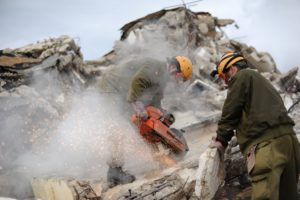
The Israel Defense Forces announced Friday that its nationwide Home Front Drill will be held next week. The drill, dubbed “Standing Firm,” is intended to prepare Israel’s civilian home front for emergency situations, and will include extensive training for Israel’s future war with Hezbollah. The IDF’s estimates in preparation for the exercise reveal that the next war will be relatively more destructive than previous confrontations between the two sides, but not the apocalyptic scenario envisioned by many.
In the decade that has passed since the Second Lebanon War, Hezbollah has undeniably become a stronger force, even though it is still no match for the IDF. Its arsenal has grown to include 150,000 rockets, expanded and improved its tunnel network in south Lebanon, and is attempting to open the Golan Heights as a second front against Israel.
The Home Front Command’s exercise takes into account this growth in Hezbollah’s strength. As a result, it will aim to prepare Israel’s civilians for the worst-case scenario of a future war with Hezbollah. It envisions that such a war will be fought on multiple fronts – placing most of Israel under fire – and will also involve Iran, Syria and Hamas. It will include a simulation of massive rocket fire on different civilian population centers, damage to critical infrastructure, cyber-attacks and failure of electrical and communication services.
According to the IDF’s estimates, these actors now possess a total of 230,000 rockets and missiles of various ranges, more than half of which are in Hezbollah’s arsenal. In a future war, they will be able to jointly fire an average 1,500 rockets daily at Israel. By comparison, during the Second Lebanon War, Hezbollah succeeded in striking Israel with a maximum of 160 rockets daily.
While the new numbers seem overwhelming, the IDF’s estimates present a more sobering and reassuring picture. According to the Home Front Command, fully 95 percent of those rockets will be of the short-range variety, with a maximum range of 28 miles and carrying just over 22 lbs of explosive material. In other words, they are inaccurate and relatively ineffective Katyusha and Grad rockets, and mortars. While the army estimates that at least 10,000 buildings will be struck, most of the damage will be concentrated in Israel’s north, with only dozens of strikes from Gaza landing in the Gush Dan region.
The army expects most of these inherently inaccurate rockets will miss their targets. But Israel is not leaving the safety of its civilians up to chance. In the past decade, Israel has developed and deployed the Iron Dome, its missile defense system designed to deal with short-range rockets like the Katyusha. As a result, the IDF estimates that only 1 percent of rockets fired at Israel will strike urban areas, but even they are expected to cause little damage due to their small explosive payload.
Israel has also upgraded its early-warning system in the face of Hezbollah’s rocket threat. Under the new system, the Home Front Command has deployed systems that can approximate a rocket’s strike zone to within one square kilometer. The new system also divides the country into 250 alert zones (compared to 25 during the 2006 war) and large cities into smaller sections. In the event of an incoming rocket attack, warning sirens will only sound in the targeted area. This would eliminate the need for massive evacuations of civilians into shelters during every rocket strike.
Between these improvements and the ineffective nature of Hezbollah’s weapons, the IDF is estimating a relatively low Israeli civilian casualty rate. In the past, Hezbollah’s leader Hassan Nasrallah has threatened to kill “tens of thousands” Israelis with rocket attacks in a future war, but the Home Front is estimating a casualty rate of “only” 250 to 500 individuals.
The expected harm to the Israel’s home front and the civilian death toll, while not catastrophic, will still be the highest suffered by the Jewish state since its War of Independence in 1948. Such a steep price will only be bearable if the IDF succeeds in dealing Hezbollah a critical blow during their next confrontation.








3 Comments
We visited Israel this past January on a visit to historical Christian sites. Our small group of Swiss Catholics were impressed by what we saw and by individuals we met of all faiths trying to lead normal lives.
I would hope that the technological means (by radar, drone or satellite) of instantly detecting the exact locations of rocket launches and rule-based responses in seconds are now firmly in place. The same for all the Hezbollah and Hamas leaders, and that they fear for their own lives if they start something. Finally, is there some system in place for volunteers from other countries come to Israel to lend a hand until a crisis situation is past? Or would such persons just be in the way?
They will end up hitting the Mosque. Or Hamas will. The Arabs will be furious and another generation of terrorists will rise up to fight Cresent. It will be 10 larger than what is happening at the moment. What is occurring at the moment in the region is not going away soon.
The most valuable and lethal weapon that Hezbollah possesses, gets better every day. These “soldiers” fighting in Syria as large functioning units capable of drone use and command and control centers, are worth their weight in gold when (and of course. .if) they come back to southern Lebanon, as valuable recruitment, and solid force control. I’m sure Israel sees this and recognizes the higher level of “soldier” that will be facing them next.